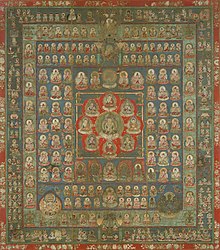Śubhakarasiṃha


Śubhakarasiṃha (637–735 CE) (traditional Chinese: 善無畏; ; pinyin: Shànwúwèi; Japanese pronunciation: Zenmui; Korean: 선무외; romaja: Seonmuoe; Vietnamese: Thiện Vô Uý) was an eminent Indian Buddhist monk and master of Esoteric Buddhism, who arrived in the Chinese capital Chang'an (now Xi'an) in 716 CE and translated the Mahāvairocana Abhisaṃbodhi Tantra, better known as the Mahāvairocana Sūtra.[1] Four years later another master, Vajrabodhi (670–741 CE), and his pupil Amoghavajra (705–775 CE), would arrive and proceeded to translate other scriptures, thus establishing a second esoteric tradition. Along with these other masters, Śubhakarasiṃha was responsible for bringing Esoteric Buddhism to the height of its popularity in China.[1]
Life in India[edit]
According to the Chinese sources, Śubhakarasiṃha was born in India as the oldest son of Buddhakara (Fo-shou Wang).[2] Li Hua's Shan-wu-wei-hsing-chuang states that his family originated in Magadha.[3] Because of unrest in their native kingdom, they had migrated to Odra (in present-day Odisha).[4] Modern scholars theorize that Śubhakarasiṃha may have been an ancestor of the Bhauma-Kara dynasty, which ruled in Odisha between 8th and 10th centuries, and whose kings included people named Śubhakara.[4]
According to his biography, Śubhakarasiṃha ascended to the throne as king when he was thirteen years old. Although emerging victorious from a power struggle with his older brothers, he turned over his position to his oldest brother and entered the monastic life. He became well known for his supernatural abilities, and finally settled in Nālandā where he met the master Dharmagupta. After being instructed by him, Śubhakarasiṃha became a traveling teacher, and was then told by Dharmagupta to go further east to China.[1]
Life in China[edit]
When Śubhakarasiṃha arrived in China, he was already eighty years old. Upon his arrival, he became well known for his supernatural abilities, and became favored by Emperor Xuanzong of the Tang dynasty. It was during this time that he translated several works of Esoteric Buddhism including the Mahāvairocana Abhisaṃbodhi Tantra.[1]
With Yixing[edit]
According to Robert Sharf, Chán Master Yi Xing (Ch. 一行禅師) was the most eminent of his students. Yixing belonged to the northern school of Chán Buddhism, but this was not seen by Chinese Buddhist culture as being fundamentally different from the esoteric teachings of Śubhakarasiṃha.[5] Around the turn of the eighth century, the northern school was known for its esoteric practices of dhāraṇīs and mantras.[6]
In Shingon Buddhism[edit]
Śubhakarasiṃha was the first patriarch of the Shingon teachings in China. Following Śubhakarasiṃha, the lineage is traced to his student Chán Master Yixing, then to Huiguo (Ch. 惠果), and finally to Kūkai (Jp. 空海), who brought the teachings of Śubhakarasiṃha and his translation of the Mahāvairocana Abhisaṃbodhi Tantra to Japan.
References[edit]
- ^ a b c d Bibhuti Baruah 2000, p. 170.
- ^ Klaus Pinte 2011, p. 340.
- ^ Richard K. Payne 2006, pp. 236–237.
- ^ a b Richard K. Payne 2006, p. 39.
- ^ Sharf, Robert (2001) Coming to Terms With Chinese Buddhism: A Reading of the Treasure Store Treatise: p. 268
- ^ Faure, Bernard (1997) The Will to Orthodoxy: A Critical Genealogy of Northern Chan Buddhism: p. 85
Bibliography[edit]
- Bibhuti Baruah (2000). Buddhist Sects and Sectarianism. Sarup & Sons. p. 170. ISBN 978-81-7625-152-5.
- Klaus Pinte (2011). "Śubhakarasiṃha (637-735)". In Charles Orzech; Henrik Sørensen; Richard Payne (eds.). Esoteric Buddhism and the Tantras in East Asia. BRILL. ISBN 978-90-04-18491-6.
- Richard K. Payne (2006). Tantric Buddhism in East Asia. Simon and Schuster. ISBN 978-0-86171-487-2.
